Atlassian Bundle
How Did Atlassian Disrupt the Software Industry?
From a bootstrapped startup to a $4.4 billion revenue powerhouse, Atlassian's journey is a masterclass in unconventional business strategy. Founded in 2002, the company defied norms by rejecting traditional sales models, choosing instead to build a global presence through innovative tactics. This article explores the Atlassian SWOT Analysis and the strategies that propelled its remarkable growth.
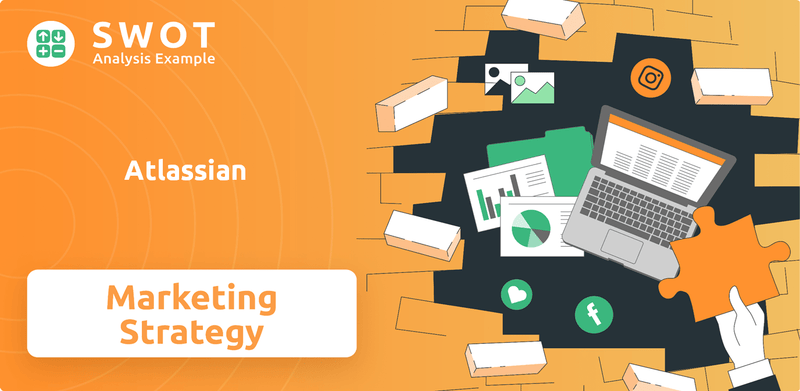
This deep dive into Atlassian's Atlassian sales strategy and Atlassian marketing strategy reveals the secrets behind its success. Discover how Atlassian's unique Atlassian go-to-market approach, centered around product-led growth, has fostered rapid customer acquisition and solidified its position as a leader in team collaboration software. We'll examine key aspects, including Atlassian products, its innovative Atlassian business model, and the effective methods it uses for Atlassian customer acquisition.
How Does Atlassian Reach Its Customers?
The sales channels of the company are primarily built around a self-service model, which is a key part of its Atlassian sales strategy. This approach emphasizes direct online purchasing through the company's website, enabling customers to complete transactions independently. This direct-to-customer model has been a cornerstone of their go-to-market strategy, especially in the early stages.
The company's products are designed to be user-friendly, encouraging a 'try and buy' approach, particularly for small and medium-sized businesses (SMBs) and smaller teams within larger organizations. While the company doesn't rely heavily on a traditional sales force, it complements its self-service model with a customer service team and a sales team focused on expanding relationships with larger customers. This structure reflects a balanced approach to customer acquisition and retention.
A significant component of the company's sales strategy involves its global network of solution partners and resellers. These partners provide crucial services such as deployment, customization, and localized support. In fiscal year 2024, over 50% of the company's revenue came from these channel partners, highlighting their importance in reaching new markets and meeting specific customer needs.
The company's primary sales channel is its website, where customers can purchase products directly. This self-service approach is designed to be user-friendly and accessible for a wide range of customers. This strategy is particularly effective for smaller businesses and teams.
The company has a global network of solution partners and resellers. These partners provide essential services such as deployment, customization, and local support. They play a crucial role in expanding the company's reach and meeting diverse customer needs.
For larger organizations, the company employs a strategic sales-led approach. This involves dedicated sales professionals who engage with customers to address complex needs. This approach is critical for cloud transformation and multi-product solutions.
The company emphasizes customer success and relationship building. The customer service team and strategic sales professionals work to ensure customer satisfaction. This approach supports long-term customer retention and growth.
The company's sales strategy is a mix of self-service, partner networks, and strategic sales for enterprises. This approach is designed to cater to different customer segments effectively. The company's focus on product-led growth is a key part of its marketing strategy.
- Self-service model for SMBs and smaller teams.
- Channel partners for broader market reach and specialized services.
- Strategic sales for enterprise customers, focusing on complex solutions.
- Customer success initiatives to retain and grow customer relationships.
Atlassian SWOT Analysis
- Complete SWOT Breakdown
- Fully Customizable
- Editable in Excel & Word
- Professional Formatting
- Investor-Ready Format
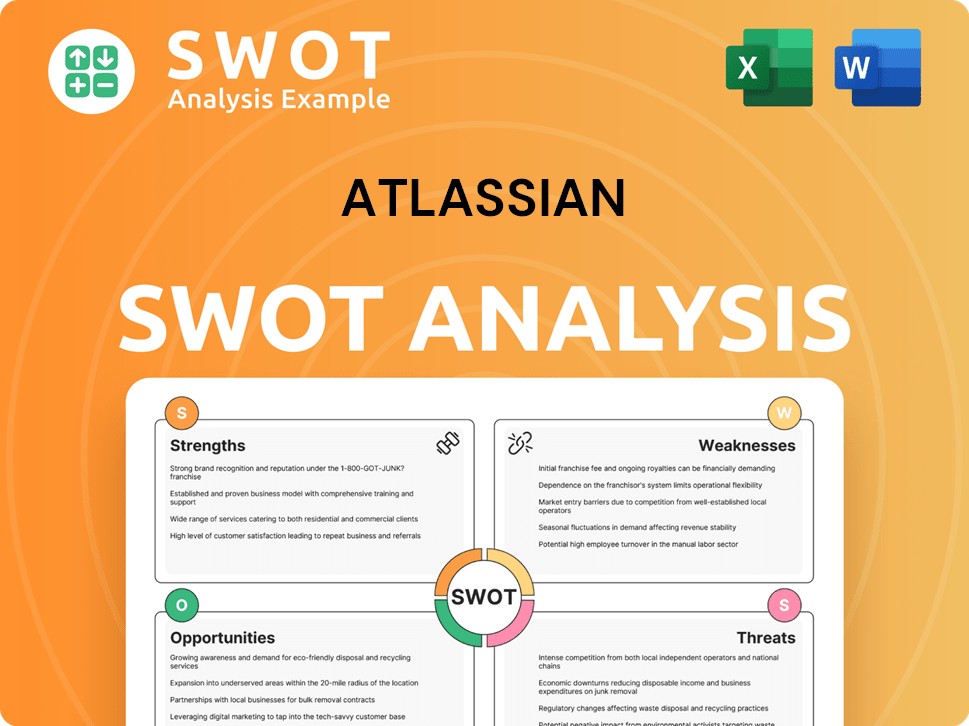
What Marketing Tactics Does Atlassian Use?
The marketing tactics employed by Atlassian are deeply intertwined with its product-led growth strategy. This approach prioritizes content and community engagement over a traditional sales force. A significant portion of revenue is reinvested in research and development, which is a key differentiator in their marketing efforts.
Digital strategies are central to Atlassian's approach, with content marketing and SEO playing crucial roles in attracting and engaging their target audience. Paid advertising and email marketing are also utilized, alongside investments in video messaging and social media to build awareness and connect with users. Data-driven insights and customer segmentation are also essential to their marketing efforts.
Atlassian's go-to-market strategy leverages a combination of digital tactics, community engagement, and data-driven insights to drive customer acquisition and retention. This comprehensive approach supports their growth and reinforces their position in the market.
Atlassian's core marketing strategy revolves around product-led growth, which emphasizes the product itself as the primary driver of customer acquisition and expansion. This strategy is supported by significant investments in research and development, with approximately 35% of revenue allocated in this area, as of 2024.
Content marketing is a cornerstone of Atlassian's strategy, particularly through resource hubs designed to attract project managers and engineers. These hubs help Atlassian dominate search engine results, driving millions of monthly visitors. The company also leverages SEO to ensure its products are easily discoverable, contributing significantly to their customer acquisition efforts.
Atlassian utilizes paid advertising, including responsive search ads, tailored to their key value propositions. They also use channels like Performance Max and Demand Gen, especially for international expansion. Email marketing is employed for lead nurturing and communication, while social media platforms are used to build awareness and engage with their user base.
The acquisition of Loom in November 2023 for $975 million highlights Atlassian's investment in video messaging. This tool is used for personalized outreach and customer support, enabling the creation of tailored video content to make messages stand out.
Data-driven marketing is central to Atlassian's strategy. They track how teams use its software to identify patterns that inform product updates and new features, aligning its product roadmap with customer behavior. Customer segmentation is evident in their creation of specific resource hubs tailored to the core needs of project managers and engineers.
Community programs are a significant marketing and engagement tool. A Community Strategist team, formed in early 2024, guides internal product and platform teams on how to leverage these programs. These programs foster user communities where administrators, power users, and team leaders share best practices and provide feedback, creating a self-reinforcing ecosystem.
Atlassian's cloud platform and the Teamwork Graph play a significant role in enabling data-driven insights and faster feature development. The Atlassian Marketplace, which generated over $1.1 billion in gross purchases of third-party apps in fiscal year 2024, also serves as a platform for third-party vendors to reach their customer base. The introduction of Atlassian Intelligence (AI) in late 2023 and early 2024, with over 30 AI features for their cloud products, is a notable innovation.
- The cloud platform and Teamwork Graph provide data-driven insights.
- The Atlassian Marketplace facilitates third-party app sales.
- Atlassian Intelligence (AI) enhances user experience and product value.
- These tools support the company's overall Atlassian marketing strategy.
Atlassian PESTLE Analysis
- Covers All 6 PESTLE Categories
- No Research Needed – Save Hours of Work
- Built by Experts, Trusted by Consultants
- Instant Download, Ready to Use
- 100% Editable, Fully Customizable
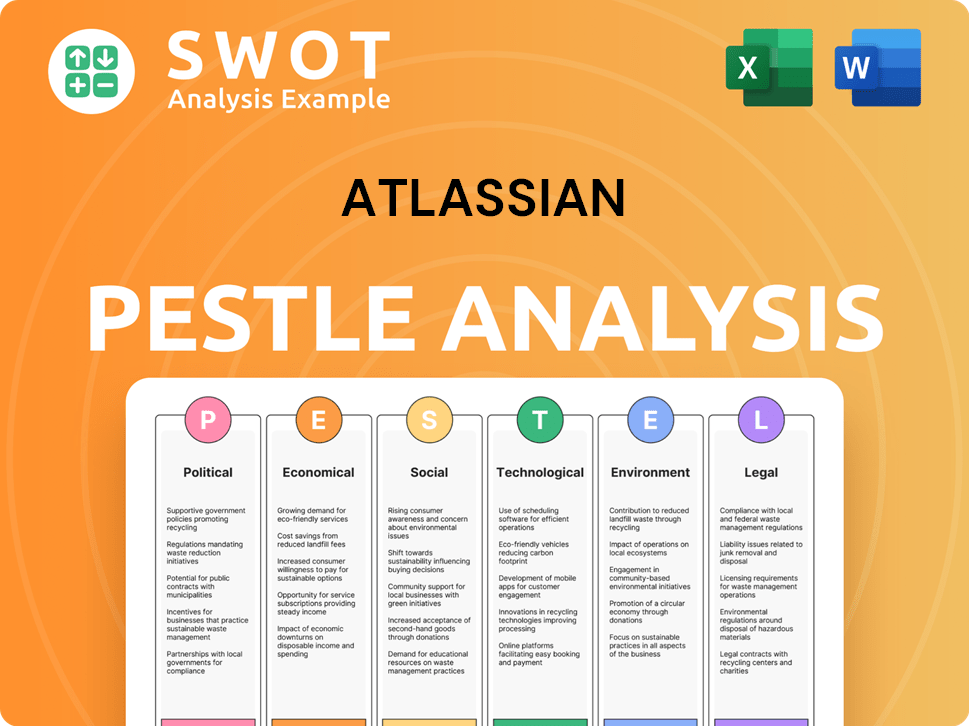
How Is Atlassian Positioned in the Market?
Atlassian's brand positioning centers on the core message of 'unleashing the potential of every team.' This message is designed to foster collaboration and teamwork, setting it apart in the software market. Its unique selling proposition involves providing powerful, flexible, customizable, and scalable tools that improve team efficiency across diverse industries, extending beyond the traditional tech audience.
The company's visual identity, refreshed at the Team '24 conference, aims to create an enduring emotional connection through simple but profound consistency. The visual language, developed with Pentagram, uses typography and mixed media to 'defamiliarize the ordinary' and express new perspectives on teamwork. This approach emphasizes a human touch in a digital environment, with the interaction of colors in overlapping shapes telling a deeper story about collaboration.
Atlassian’s commitment to product excellence and customer-centricity reinforces its brand image, building trust and loyalty. Innovation, especially with the integration of AI into its products, such as Atlassian Intelligence and Rovo, addresses evolving customer needs and maintains a competitive edge. These AI-powered features aim to optimize workflows and automate tasks.
Atlassian's brand is built on the idea of empowering teams. This is achieved through tools that promote collaboration and efficiency. This focus helps them stand out in a competitive market.
The company emphasizes product excellence. This is done by investing heavily in research and development. This strategy helps in creating tools that users genuinely enjoy.
Brand consistency is maintained across all channels. This includes the website, product interfaces, and marketing communications. This consistency builds a strong brand identity.
Atlassian continuously innovates, integrating AI into its products. Features like Atlassian Intelligence and Rovo enhance workflows. This helps in staying competitive.
Atlassian's brand positioning is further strengthened by its product-led growth model. This approach is evident in its significant investment in research and development, aiming to deliver tools that users love. The company's core values of openness, collaboration, and customer centricity build trust and loyalty. This strategy is crucial for Growth Strategy of Atlassian. The company's commitment to innovation is reflected in its top position on the 2024 Fortune Future 50 list, recognizing its long-term growth and commitment to collaboration. The company's approach to brand awareness strategies is closely tied to its product-led growth model, which emphasizes providing value through its tools and fostering community engagement.
Atlassian Business Model Canvas
- Complete 9-Block Business Model Canvas
- Effortlessly Communicate Your Business Strategy
- Investor-Ready BMC Format
- 100% Editable and Customizable
- Clear and Structured Layout
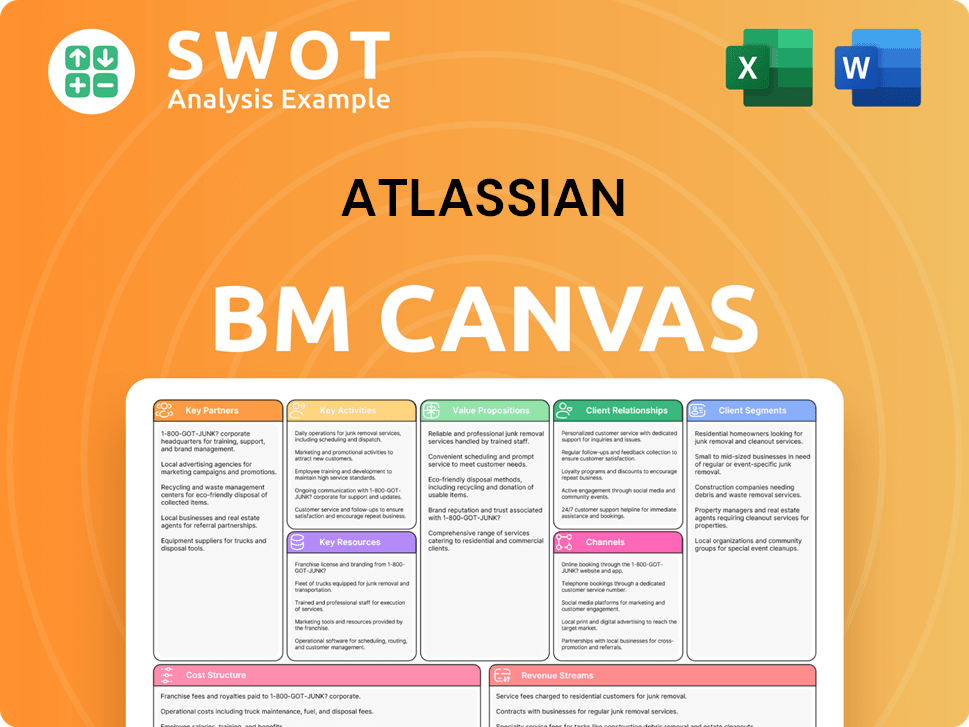
What Are Atlassian’s Most Notable Campaigns?
The sales and marketing strategy of the company is distinguished by its consistent focus on product innovation and ecosystem development. Instead of relying on traditional, large-scale advertising campaigns, it has adopted a product-led growth (PLG) model. This approach emphasizes quality products and customer self-service, which has been key to its expansion, generating over $4.4 billion in annual revenue in fiscal year 2024 and serving more than 300,000 customers. This strategy has proven effective for Atlassian's customer acquisition and retention.
One of the most impactful 'campaigns' has been the 'Cloud Migration' initiative. With the end of support for server products on February 15, 2024, the company strongly encouraged businesses to move to the cloud. The objective was to ensure security, compliance, and access to future innovations. The company provides extensive support and resources for businesses undergoing this transition. This has been crucial for its future growth, with cloud revenue expected to grow by approximately 23% year-over-year in FY25.
Another key area is the continuous integration and promotion of 'Atlassian Intelligence' (AI) across its product suite. Launched publicly in December 2023, with over 30 AI features announced for cloud products by August 2024, this initiative aims to deliver significant value to customers. The goal is to increase productivity, automate tasks, and provide actionable insights. The success of Atlassian Intelligence is evident, with nearly 3x quarter-over-quarter growth in monthly active usage as of August 2024. For more insights into their overall strategy, consider exploring the Growth Strategy of Atlassian.
This core strategy focuses on offering high-quality products and customer self-service to drive growth. It emphasizes intuitive products, transparent pricing, and low barriers to entry. The approach has resulted in significant revenue and a strong customer base.
Encouraging customers to migrate to the cloud is a key campaign. This initiative ensures security, compliance, and access to future innovations. It is supported by extensive resources and is crucial for future growth, with cloud revenue expected to increase significantly.
The integration of AI across its product suite is a major focus. It aims to increase productivity, automate tasks, and provide insights. This includes features like natural language input and AI-driven summaries, with significant growth in active usage.
The annual conference serves as a major marketing platform. It is used to announce new products and features and to highlight the 'System of Work' strategy. The conference emphasizes breaking down information silos and aligning work to organizational goals.
This strategy focuses on offering high-quality products and self-service. It relies on intuitive products, transparent pricing, and low barriers to entry. This approach has driven significant revenue growth and customer acquisition.
The initiative to move customers to the cloud is a key campaign. It ensures security, compliance, and access to future innovations. The company provides extensive support, and cloud revenue is expected to grow substantially.
The integration of AI across its product suite is a major focus. It aims to enhance productivity, automate tasks, and provide actionable insights. This includes features like natural language input and AI-driven summaries.
The annual conference serves as a major marketing platform. It is used to announce new products and features and to highlight the 'System of Work' strategy. The conference emphasizes breaking down information silos.
Collaborations with partners, such as the Accenture partnership formed in 2023, boost brand visibility and credibility. These partnerships also contribute to channel sales, which account for a significant portion of revenue.
Atlassian Porter's Five Forces Analysis
- Covers All 5 Competitive Forces in Detail
- Structured for Consultants, Students, and Founders
- 100% Editable in Microsoft Word & Excel
- Instant Digital Download – Use Immediately
- Compatible with Mac & PC – Fully Unlocked
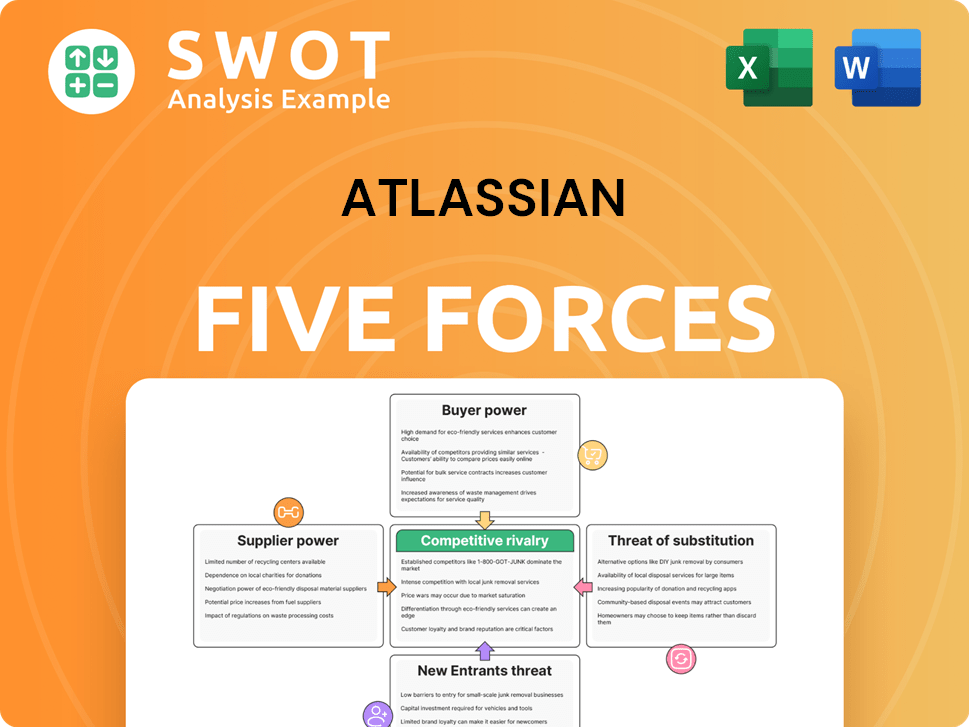
Related Blogs
- What are Mission Vision & Core Values of Atlassian Company?
- What is Competitive Landscape of Atlassian Company?
- What is Growth Strategy and Future Prospects of Atlassian Company?
- How Does Atlassian Company Work?
- What is Brief History of Atlassian Company?
- Who Owns Atlassian Company?
- What is Customer Demographics and Target Market of Atlassian Company?
Disclaimer
All information, articles, and product details provided on this website are for general informational and educational purposes only. We do not claim any ownership over, nor do we intend to infringe upon, any trademarks, copyrights, logos, brand names, or other intellectual property mentioned or depicted on this site. Such intellectual property remains the property of its respective owners, and any references here are made solely for identification or informational purposes, without implying any affiliation, endorsement, or partnership.
We make no representations or warranties, express or implied, regarding the accuracy, completeness, or suitability of any content or products presented. Nothing on this website should be construed as legal, tax, investment, financial, medical, or other professional advice. In addition, no part of this site—including articles or product references—constitutes a solicitation, recommendation, endorsement, advertisement, or offer to buy or sell any securities, franchises, or other financial instruments, particularly in jurisdictions where such activity would be unlawful.
All content is of a general nature and may not address the specific circumstances of any individual or entity. It is not a substitute for professional advice or services. Any actions you take based on the information provided here are strictly at your own risk. You accept full responsibility for any decisions or outcomes arising from your use of this website and agree to release us from any liability in connection with your use of, or reliance upon, the content or products found herein.